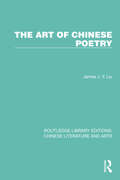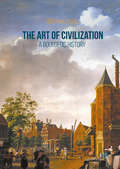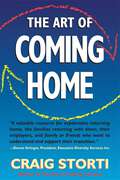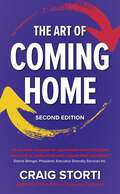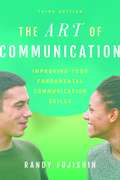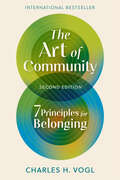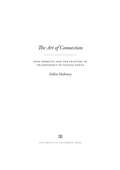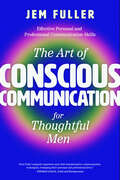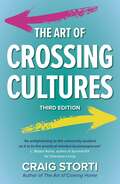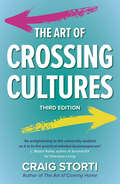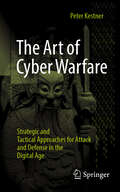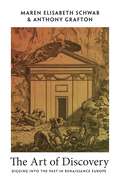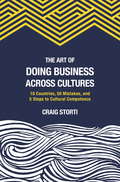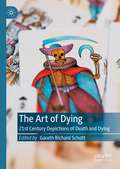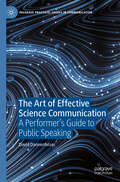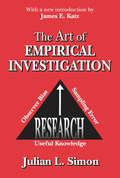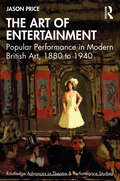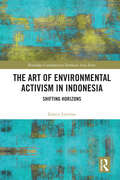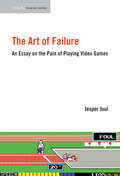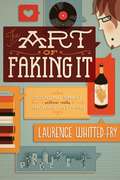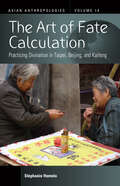- Table View
- List View
The Art of Chinese Poetry (Routledge Library Editions: Chinese Literature and Arts #1)
by James J.Y. LiuThis book, first published in 1962, is a majestic survey of the whole structure of Chinese poetry. It is a critical introduction to the field as well as an exposition of Chinese views on the nature of poetry. It discusses the Chinese language as a poetic medium from various angles – visual, semantic, auditory, grammatical and conceptual. It also describes the bases of Chinese versification and the major verse forms, and offers interpretations of various schools of traditional Chinese criticisms of poetry. The author suggests a synthesis among the different schools and evolves a view of poetry from which critical standards for Chinese poetry can be derived. In applying these standards, he attempts a further synthesis – one between this mainly traditional Chinese view of poetry and the modern Western method of verbal analysis. Imagery, symbolism, allusions and other features of Chinese poetry are analysed critically.
The Art of Civilization
by Didier MaleuvreDidier Maleuvre argues that works of art in Western societies from Ancient Greece to the interconnected worlds of the Digital Age have served to rationalize and normalize an engagement with bourgeois civilization and the city. Maleuvre details that the history of art itself is the history civilization, giving rise to the particular aesthetics and critical attitudes of respective moments and movements in changing civilizations in a dialogical mode. Building a visual cultural account of shifting forms of culture, power, and subjectivity, Maleuvre illustrates how art gave a pattern and a language to the model of social authority rather than simply functioning as a reflective one. Through a broad cultural study of the relationship between humanity, art, and the culture of civilization, Maleuvre introduces a new set of paradigms that critique and affirm the relationship between humanity and art, arguing for it as an engine of social reproduction that transforms how culture is inhabited.
The Art of Clothing: A Pacific Experience
by Graeme Were Susanne KüchlerThe Art of Clothing: A Pacific Experience is a collection of richly textured and tremendously engaging empirical studies of cloth and clothing in colonial and post-colonial Pacific contexts. By challenging readers to reconsider the very nature of the materiality of clothing, the editors productively situate this volume at the intersection of a number of ongoing interdisciplinary projects that are coalescing around an interest in cloth and clothing. The book as a whole speaks lucidly to issues of current concern in a wide range of academic fields - including cultural studies, material culture, Pacific history, art history, history of religions, and museum studies.
The Art of Coexistence: Pioneering Role of Fethullah Gulen and the Hizmet Movement
by Ismail Albayrak Salih YucelThe global threat of war, terrorism, the increased gap between poor and rich, famine, malnutrition, global warming and pollution, and many other social and cultural problems, pose a real challenge for present citizens of the globe. Intellectuals and politicians take these challenges as their primary concerns. Despite the existence of some pessimists, there are a number of initiatives working for the common good and expending great effort to solve these problems. The Hizmet (Gulen) Movement is one of the most influential initiatives that should be taken into consideration in this context. Fethullah Gulen is a Turkish Muslim scholar whose ideas have inspired and influenced many Turkish intellectuals, educators, students, businessmen, politicians and journalists inside and outside Turkey to establish schools, educational and intercultural centers, and humanitarian aid organizations in more than one hundred fifty countries. Yucel and Albayrak cover the Hizmet Movement under the leadership of Fethullah Gulen from various perspectives in order to shed lights on current discussions.
The Art of Coming Home
by Craig StortiUpdated 2nd Edition!If you were lucky, you knew about and were prepared for culture shock when you moved overseas, but unless you are very lucky, you probably don&’t know about and are not prepared for reverse culture shock. And you should be. Most expats find coming home after an overseas assignment more difficult than adjusting to a foreign culture—and very few organizations and companies prepare people for the experience.Veteran trainer and consultant Craig Storti sketches the workplace challenges faced by returning businessmen and women as well as the re-entry issues of spouses, younger children, and teenagers. He also addresses in detail the special issues faced by exchange students, international development volunteers, and military and missionary personnel and their families.If you&’re about to relocate abroad, are already living abroad, about to come home, or already home, this book walks you through the biggest adjustments, personal and professional, and in this new edition presents a complete do-it-yourself repatriation workshop to help you identify and address your individual readjustment issues.
The Art of Coming Home
by Craig StortiIf you were lucky, you knew about and were prepared for culture shock when you moved overseas, But unless you are very lucky, you probably don't know about and are not prepared for reverse culture shock. And you should be. Most expats find coming home after an overseas assignment more difficult than adjusting to a foreign culture-and very few organizations and companies prepare people for the experience.Veteran trainer and consultant Craig Storti sketches the workplace challenges faced by returning businessmen and women as well as the re-entry issues of spouses, younger children, and teenagers. He also addresses in detail the special issues faced by exchange students, international development volunteers, and military and missionary personnel and their families.From leave-taking and the honeymoon stage through to reverse culture shock and eventual readjustment, The Art of Coming Home lays out the four stages of the re-entry process and details practical strategies for dealing with the challenges you will face each step of the way.Whether you're about to relocate abroad, are already living abroad, about to come home, or already home, this book walks you through the biggest adjustments, personal and professional, and in this new edition presents a complete do-it-yourself repatriation workshop to help you identify and address your individual readjustment issues.
The Art Of Communication: Improving Your Fundamental Communication Skills (Third Edition)
by Randy FujishinThis third edition of The Art of Communication (previously titled Creating Communication) is a brief and practical introduction to speech communication. Emphasizing face-to-face communication, yet also addressing the role of technology and its influence on daily communication, Fujishin helps you develop greater understanding of how important communication skills are in your personal and professional life--and will inspire you to use these skills in ways that enlarge and improve the lives of others as well as your own. Fujishin employs a distinctively encouraging and conversational approach as he explains the basic communication skills necessary to improve in numerous contexts--including public speaking, small group, interpersonal, intercultural, leadership, interviewing, and technology-based communication. The result is an easy-to-read book that provides the tools to implement powerful changes in the ways you interact with others.
The Art of Community, Second Edition: 7 Principles for Belonging
by Charles H. VoglSecond edition of this bestselling book on creating robust, thriving, positive communities using seven ancient principles any organization can follow.Now with 25% new content, including a chapter on building virtual communities.Healthy communities strive for their members to support one another, share their passions, and achieve personal growth. This book will help you learn to be connected and defeat loneliness by understanding where and how we belong. No matter the kind of organization, company, or social group, this book is a guide for leaders seeking to build a community or strengthen the ones they already have.Drawing on both 3,000 years of history and his personal experience, Charles Vogl lays out seven time-tested principles for developing connected communities that last. These include:•Boundary: The boundary between members and outsiders•Initiation: The activities that mark a new member•Rituals: The things we do that have meaning•Temple: A place set aside to find our community•Stories: What we share that allows others and ourselves to know our values•Symbols: The things that represent ideas that are important to us•Inner Rings: A path to growth as we participateWith hands-on tools for applying these principles to any group-formal or informal, mission driven or social, physical or virtual-this book will guide you in your journey to become a community builder that brings people together
The Art of Connection: Risk, Mobility, and the Crafting of Transparency in Coastal Kenya
by Dillon MahoneyThe Art of Connection narrates the individual stories of artisans and traders of Kenyan arts and crafts as they overcome the loss of physical access to roadside market space by turning to new digital technologies to make their businesses more mobile and integrated into the global economy. Bringing together the studies of globalization, development, art, and communication, the book illuminates the lived experiences of informal economies and shows how traders and small enterprises balance new risks with the mobility afforded by digital technologies. An array of ethnic and generational politics have led to market burnings and witchcraft accusations as Kenya’s crafts industry struggles to adapt to its new connection to the global economy. To mediate the resulting crisis of trust, the Fair Trade sticker and other NGO aesthetics continue to successfully represent a transparent, ethical, and trusting relationship between buyer and producer. Dillon Mahoney shows that by balancing revelation and obfuscation—what is revealed and what is not—Kenyan art traders make their own roles as intermediaries and the exploitative realities of the global economy invisible.
The Art of Conscious Communication: Effective Personal and Professional Communication Skills
by Jem Fuller&“An enlightening guide to redefining masculinity . . . helping [the modern man] navigate conversations with empathy, clarity, and respect.&” —Scott Jeffrey Miller, bestselling author and podcast host Embrace the power of conscious communication and become part of a new generation of emotionally aware, respectful men. Your journey towards enhanced relationships and a more fulfilling life begins here. In this transformative guide, author Jem Fuller draws on 20 years of coaching and leadership, providing strategies to enhance communication skills. Explore the depths of personal discovery through honest stories, discovering how small steps in awareness can lead to significant changes in relationships and results. It&’s not just a book. In a world where communication shapes the essence of our relationships and results, Fuller challenges conventional norms that may hinder effective expression. The Art of Conscious Communication for Thoughtful Men is a guide to thinking, focusing, acting, and communicating in ways that profoundly impact both individual lives and the lives of those around you. The book urges men to break free from societal constraints, offering practical strategies for navigating complex emotions and conversations. As you delve into Jem&’s colorful life experiences and leadership insights, witness the potential for positive societal change and a more fulfilling life through the profound impact of conscious communication. Inside, you&’ll find: Masterful coaching strategies for effective communication Leadership insights honed over two decades Practical guidance for navigating complex emotions Stories from a diverse life, enhancing cultural understanding If you liked books such as The First Minute, The Effective Communication Method, or 7 Winning Conflict Resolution Techniques, you&’ll love The Art of Conscious Communication for Thoughtful Men.
The Art of Crossing Cultures
by Craig StortiAdjusting to a new culture and getting along with the local people can be a challenge for everyone who lives and works abroad. Whether in business, diplomacy, education, or as a long-term visitor, anyone can be blind-sided by a lack of international knowledge and experience and be caught at a disadvantage.In this completely revised and expanded third edition, Craig Storti outlines the personal challenges of adjusting to the change - anticipating differences, managing the temptation to withdraw, and gradually adjusting expectations of behaviour to fit reality - and shows what it takes to encounter a new culture head-on and succeed. Now an established bestseller, The Art of Crossing Cultures is a one-of-a-kind guidebook to bridging the cultural divide, incorporating an easy-to-understand model of cultural adjustment, and tips on how to master the process and develop adaptive strategies. This timely new edition focuses on how to deal with country and culture shock and includes many examples of cross-cultural misunderstandings. As well as revisions throughout, it includes a brand new chapter on crossing cultures at home."As enlightening to the university student as it is to the practical-minded businessperson." L. Robert Kohls, author of Survival Kit for Overseas Living
The Art of Crossing Cultures, 3rd Edition
by Craig StortiFrom the author of Why Travel Matters, the third edition of the essential book to bridge cultures and countries.Adjusting to a new culture and getting along with the local people challenge everyone who lives and works abroad. Whether in business, diplomacy, education, or as a long-term visitor abroad, anyone can be blind-sided by a lack of international knowledge and experience and be caught at a disadvantage.In this completely revised and expanded edition of the classic The Art of Crossing Cultures, Craig Storti shows what it takes to encounter a new culture head-on and succeed. This one-of-a-kind guidebook to bridging the cultural divide - with more than 50,000 copies sold worldwide - incorporates a stellar sampling of the writings of some of the world's greatest writers, poets and observers of the human condition.Through the vivid perceptions and words of such literary legends as Noel Coward, Graham Greene, Rudyard Kipling, E. M. Forster, Mark Twain, Evelyn Waugh, and others, Storti paints an intimate portrait of the personal challenges of adjusting to another culture: anticipating differences, managing the temptation to withdraw, and gradually adjusting expectations of behavior to fit reality.This timely new edition focuses special attention on how to deal with country and culture shock and includes many new examples of cross-cultural misunderstandings - particularly in business. Storti breaks new ground with his easy-to-understand model of cultural adjustment and tips on how to master the process and develop adaptive strategies - the heart of the cross-cultural experience.
The Art of Cyber Warfare: Strategic and Tactical Approaches for Attack and Defense in the Digital Age
by Peter KestnerThe Art of Cyber Warfare explores the strategic and tactical approaches for offense and defense in the digital age. Drawing on historical conflicts from Sun Tzu to Carl von Clausewitz, the author illustrates that, despite changed conditions such as time, location, means, and resources – but not the laws of physics – it is possible to learn from past actions and reactions.The author aims to demonstrate in this book that, in reality, we have only transferred old methods into our current era but have forgotten to translate their reasons, effects, and the resulting lessons. For, as it has been for thousands of years, the reasons for human-created conflicts remain the same: wealth, fame, power, honor, or desire. Can we learn something from history for present and future (cyber) wars?
The Art of Discovery: Digging into the Past in Renaissance Europe
by Maren Elisabeth Schwab Anthony GraftonA panoramic history of the antiquarians whose discoveries transformed Renaissance culture and gave rise to new forms of art and knowledgeIn the early fifteenth century, a casket containing the remains of the Roman historian Livy was unearthed at a Benedictine abbey in Padua. The find was greeted with the same enthusiasm as the bones of a Christian saint, and established a pattern that antiquarians would follow for centuries to come. The Art of Discovery tells the stories of the Renaissance antiquarians who turned material remains of the ancient world into sources for scholars and artists, inspirations for palaces and churches, and objects of pilgrimage and devotion.Maren Elisabeth Schwab and Anthony Grafton bring to life some of the most spectacular finds of the age, such as Nero’s Golden House and the wooden placard that was supposedly nailed to the True Cross. They take readers into basements, caves, and cisterns, explaining how digs were undertaken and shedding light on the methods antiquarians—and the alchemists and craftspeople they consulted—used to interpret them. What emerges is not an origin story for modern archaeology or art history but rather an account of how early modern artisanal skills and technical expertise were used to create new knowledge about the past and inspire new forms of art, scholarship, and devotion in the present.The Art of Discovery challenges the notion that Renaissance antiquarianism was strictly a secular enterprise, revealing how the rediscovery of Christian relics and the bones of martyrs helped give rise to highly interdisciplinary ways of examining and authenticating objects of all kinds.
The Art of Doing Business Across Cultures: 10 Countries, 50 Mistakes, and 5 Steps to Cultural Competence
by Craig Storti50 common cultural mistakes made in business are presented in the form of short conversations which show that there's always a reason why people do the strange things they do, the reason is almost never to upset you, and there's always a way round.The Art of Doing Business Across Cultures presents five brief, unsuccessful conversational exchanges between Americans and their business colleagues in 10 different locations-the Arab Middle East, Brazil, China, England, France, Germany, India, Japan, Mexico, and Russia.
The Art of Dying: Living Fully into the Life to Come
by Rob MollDeath will come to us all, but most of us live our lives as if death did not exist. Medicine has made dying more complicated and more removed from the experience of most people. Death is partitioned off to hospital rooms, separated from our daily lives. Most of us find ourselves at a loss when death approaches. We don't know how to die well. For centuries Christians have prepared for the "good death" with particular rituals and spiritual disciplines that direct the actions of both the living and the dying. In this well-researched and pastorally sensitive book, Rob Moll explores the Christian practice of dying well. He gives guidance for those who care for the dying as well as for those who grieve. This book is a gentle companion for all who face death, whether one's own or that of a loved one. Christians can have confidence that because death is not the end, preparing to die helps us truly live. A decade after writing this book, Rob died in a hiking accident at age forty-one. This edition includes a new afterword by his wife, Clarissa Moll, reflecting on Rob's life, death, and legacy.
The Art of Dying: 21st Century Depictions of Death and Dying
by Gareth Richard SchottThe Art of Dying: 21st Century Depictions of Death and Dying examines how contemporary media platforms are used to produce creative accounts, responses and reflections on the course of dying, death and grief. Outside the public performance of grief at funerals, grief can strike in anticipation of a loss, or it can endure, continuing to interject itself and interrupt a permanently changed life. This book examines the particular affordances possessed by various contemporary creative forms and platforms that capture and illuminate different aspects of the phenomenology of dying and grief. It explores the subversive and unguarded nature of stand-up comedy, the temporal and spatial inventiveness of graphic novels, the creative constructions of documentary filmmaking, the narrative voice of young adult literature, the realism of documentary theatre, alongside more ubiquitous media such as social media, television and games. This book is testament to the power of creative expression to elicit vicarious grief and sharpen our awareness of death.
The Art of Eating Through the Zombie Apocalypse: A Cookbook and Culinary Survival Guide
by Lauren WilsonJust because the undead's taste buds are atrophying doesn't mean yours have to! You duck into the safest-looking abandoned house you can find and hold your breath as you listen for the approaching zombie horde you've been running from all day. You hear a gurgling sound. Is it the undead? No—it's your stomach. When the zombie apocalypse tears down life and society as we know it, it will mean no more take out, no more brightly lit, immaculately organized aisles of food just waiting to be plucked effortlessly off the shelves. No more trips down to the local farmers' market. No more microwaved meals in front of the TV or intimate dinner parties. No, when the undead rise, eating will be hard, and doing it successfully will become an art. The Art of Eating through the Zombie Apocalypse is a cookbook and culinary field guide for the busy zpoc survivor. With more than 80 recipes (from Overnight of the Living Dead French Toast and It's Not Easy Growing Greens Salad to Down & Out Sauerkraut, Honey & Blackberry Mead, and Twinkie Trifle), scads of gastronomic survival tips, and dozens of diagrams and illustrations that help you scavenge, forage, and improvise your way to an artful post-apocalypse meal. The Art of Eating is the ideal handbook for efficient food sourcing and inventive meal preparation in the event of an undead uprising. Whether you decide to hole up in your own home or bug out into the wilderness, whether you prefer to scavenge the dregs of society or try your hand at apocalyptic agriculture, and regardless of your level of skill or preparation, The Art of Eating will help you navigate the wasteland and make the most of what you eat.
The Art of Effective Science Communication: A Performer's Guide to Public Speaking (Palgrave Practical Guides in Communication)
by David DannenfelserThis book shows readers how the arts of improvisational theater and acting can help scientists and other experts speak about technical research to lay audiences.Focused on public speaking, this book translates the principles and processes used by actors and other theater professionals into a method for communicating science to the general public. The book is structured as a step-by-step examination of how to write an effective speech and then a guide to carefully analyzing that speech as an actor does in rehearsal before finally sharing it with an audience as a performance. In other words, the book helps science communicators identify what to say and how to say it. This book also includes prompts and exercises that the author has used in classes and workshops with scientists.
The Art of Empirical Investigation
by Julian L. Simon James E. KatzJulian Simon was known for his methodical, and often controversial, writings challenging conventional beliefs about overpopulation, pollution, disappearing farmland, and the scarcity of energy sources and raw materials. But throughout his works is a common theme: that responsible, unbiased research and examination of the data is indispensable to formulating a well-informed and accurate opinion. The Art of Empirical Investigation teaches student, professor, researcher, and those interested in ascertaining the truth about social issues just how to proceed.The Art of Empirical Investigation is a textbook on the basics of social-scientific research. It discusses all the important empirical methods used in social science, and its examples, drawn from a wide variety of academic and applied fields, illustrate the use of each method in its most appropriate context. The actual decisions a researcher must make at every stage of a project are emphasized, as well as obstacles to knowledge--such as observer bias, deception, unreliability of data, and sampling costs--and how to overcome them. Presupposing nothing, the book introduces the reader to the foundations of empirical social-science research, regardless of a specific field. It also makes an important contribution to beginning researchers' understanding of an operational definition of causality, which cuts through philosophical obscurity and teaches the researcher how to decide whether or not a given relationship is causal.
The Art of Entertainment: Popular Performance in Modern British Art, 1880 to 1940 (ISSN)
by Jason PriceIn this book, theatre historian Jason Price looks at the relationships and exchanges that took place between high and low cultural forms in Britain from 1880 to 1940, focusing on the ways in which figures from popular entertainments, such as music hall serio-comics, clowns, and circus acrobats, came to feature in modern works of art.Readers with an interest in art, theatre, and the history of modern Britain will find Price’s approach, which sees major works of art used to illuminate the histories of once-famous entertainers and the wider social, political, and cultural landscape of this period, accessible and engaging. The book will bring to life for readers some of the most vivid works of modern British art and reveal how individuals historically overlooked due to their gender, sexuality, or race played a significant role in the shaping of British culture during this period of monumental social change.
The Art of Environmental Activism in Indonesia: Shifting Horizons (Routledge Contemporary Southeast Asia Series)
by Edwin JurriënsThis book analyses the intersections between contemporary art and environmental activism in Indonesia. Exploring how the arts have promoted ecological awareness from the late 1960s to the early 2020s, the book shows how the arts have contributed to societal change and public and political responses to environmental crises. This period covers Indonesia’s rapid urban development under the totalitarian New Order regime (1967–1998) as well as the enhanced freedom of expression, alternative development models, and environmental problems under the democratic governments since 1998. The book applies the concept of ‘artivism’ to refer to the vital role of art in activism. It seeks to identify and contextualise both the potential and limits of environmental artivism in Indonesia, a country whose vibrant art scenes and monumental social transformations provide a productive laboratory for exploring the power of creativity as a social and political change agent. It provides a comprehensive overview of contemporary art from Indonesia, with an in-depth analysis of artivists who seek to address and find solutions for some of the most pressing environmental issues of our times. With its detailed, empirical approach to environmental art from Southeast Asia, this project fills in an important gap in the literature on art and activism. It is aimed at academics, students, artists, curators, policymakers, activists, and general readers with an interest in the environment, art history, and Indonesian culture, society, and politics.
The Art of Failure: An Essay on the Pain of Playing Video Games (Playful Thinking)
by Jesper JuulAn exploration of why we play video games despite the fact that we are almost certain to feel unhappy when we fail at them. We may think of video games as being "fun," but in The Art of Failure, Jesper Juul claims that this is almost entirely mistaken. When we play video games, our facial expressions are rarely those of happiness or bliss. Instead, we frown, grimace, and shout in frustration as we lose, or die, or fail to advance to the next level. Humans may have a fundamental desire to succeed and feel competent, but game players choose to engage in an activity in which they are nearly certain to fail and feel incompetent. So why do we play video games even though they make us unhappy? Juul examines this paradox. In video games, as in tragic works of art, literature, theater, and cinema, it seems that we want to experience unpleasantness even if we also dislike it. Reader or audience reaction to tragedy is often explained as catharsis, as a purging of negative emotions. But, Juul points out, this doesn't seem to be the case for video game players. Games do not purge us of unpleasant emotions; they produce them in the first place. What, then, does failure in video game playing do? Juul argues that failure in a game is unique in that when you fail in a game, you (not a character) are in some way inadequate. Yet games also motivate us to play more, in order to escape that inadequacy, and the feeling of escaping failure (often by improving skills) is a central enjoyment of games. Games, writes Juul, are the art of failure: the singular art form that sets us up for failure and allows us to experience it and experiment with it. The Art of Failure is essential reading for anyone interested in video games, whether as entertainment, art, or education.
The Art of Faking It: Sounding Smart Without Really Knowing Anything
by Laurence Whitted-FryIn today’s fast-paced society, who has time to keep up with both the current trends and the classics of what is “good” and “popular”? <P><P>The Art of Faking It guides you—with tongue planted firmly in cheek—through any awkward, intellectual, and/or über-sophisticated social situation, using both panache and pithy nuggets of wisdom to ensure you’ll never be at a loss for the right words and attitudes again. Inside you will find everything you need to know about what everyone is talking about— from ordering the “right” food and drink to holding an intelligent conversation about anything, from classical music and architecture to legitimate theater and the opposite sex. With the timely information and savvy advice in this book, playfully illustrated with New Yorker-esque line drawings, you will be the most scintillating conversationalist in the bunch—whether you are faking it or not!
The Art of Fate Calculation: Practicing Divination in Taipei, Beijing, and Kaifeng (Asian Anthropologies #14)
by Stéphanie HomolaFrom housewives to students and high-ranking officials, people from all social backgrounds in China and Taiwan visit fate calculation masters to learn about their destiny. How do clients assess the diviner’s skills? How does one become a fortune-teller? How is a person’s fate calculated? The Art of Fate Calculation explores how conceptions of fate circulate in Chinese and Taiwanese societies while resisting uniformization and institutionalization. This is not only due to the stigma of “superstition” but also to the internal dynamic of fate calculation practice and learning.
